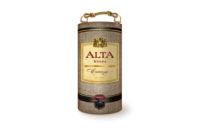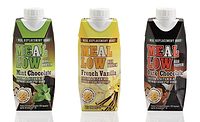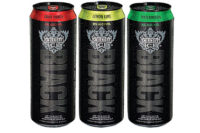Convenience, portability affect packaging selection
Cartons, pouches and aseptic containers appeal to different consumer need states

Carton packaging has appeal across different age segments, according to Mintel’s “Beverage Packaging Trends — US” report. (Image courtesy of NextFoods)

Mintel recommends utilizing aseptic packaging for smaller-portioned, on-the-go categories for both kids and adults. Vita Coco Kids is packaged in Tetra Pak’s Wedge Aseptic carton. (Image courtesy of Vita Coco)

Suppliers foresee spouted, reclosable pouches to be a trend going forward for beverages. (Image courtesy of Good Time Beverages)



Understanding consumer wants and needs can be crucial when it comes to product development and sustainability. Suley Muratoglu, vice president of marketing and product development for Vernon Hills, Ill.-based Tetra Pak Inc., explains that consumers are seeking better-for-you drinks that are convenient and also easy on the environment. Therefore, beverage-makers should develop products that are “right-sized” for portion control, feature ingredients that appeal to health and fitness, and are packaged in environmentally friendly and sustainable formats, he suggests.
“Today, nearly 60 percent of households in the United States are comprised of one or two individuals, and more and more we are seeing convenience, size, [and] ease of storage and disposal drive consumers toward the need for greater efficiency in their day-to-day lives,” he says. “Consumers are looking for products that fit their lifestyle; they want to avoid spoilage and save money while also [having] the chance for more variety.”
Additionally, as the number of non-nuclear families increases, so have the implications for packaging sizes, Muratoglu says. “As consumers continue to lead busy lives away from home, both in their professional and leisure time, smaller portions have become an important new sector of growth in the beverage industry, particularly in the juice aisle,” he adds.
Tree of life
According to Chicago-based Mintel’s February report “Beverage Packaging Trends – US,” carton packaging has appeal across different age segments. Among 2,000 surveyed Internet users ages 18 and older, 43 percent consider cartons recyclable; 38 percent view them as traditional; and 33 percent see cartons as environmentally friendly, the market research firm reports. Respondents also associated “value,” “portability,” “quality” and “ability to retain freshness,” which came in at 33, 25, 24 and 19 percent, respectively, with the packaging format. Sixteen percent responded that cartons do not feature any of these characteristics.
“Cartons are a smart, responsible choice for a variety of refrigerated beverage products because they meet consumer needs for freshness and eco-friendly packaging options to provide beverage-makers with an excellent brand-building vehicle,” says Erin Reynolds, marketing director for Memphis, Tenn.-based Evergreen Packaging. “Cartons are especially valuable for premium brands. Data also indicates that consumers are willing to pay a premium for products if they clearly understand the benefit the product offers. Paperboard cartons allow brands to take full advantage of four billboard panels of vibrant, full-color graphics to tell a premium product brand story.”
Reynolds adds that cartons can meet a number of the eco-friendly attributes that consumers are seeking. “Cartons help protect freshness and prevent food waste without overpackaging,” she says. “Cartons are also recyclable for over 51 million households. In addition, more than 75 percent of the carton is made from paper, which comes from a renewable resource — trees.”
Offering paperboard cartons for refrigerated beverages, such as juice, milk, milk substitutes, iced coffee and teas, Evergreen Packaging is developing packaging solutions to meet consumers’ need states, Reynolds explains.
“We always want to be aligned with consumer values and lifestyles, and we’ll continue to develop products based on market and consumer trends,” she says. “For example, Evergreen’s latest innovation, Fresh-Look cartons, are cartons with windows. They directly address key consumer desires to see packaging contents and to know when they’re running low while maintaining all the branding freshness and environmental benefits that brands expect from Evergreen’s paperboard cartons.”
Reynolds estimates that the paperboard carton market is stable but says that Evergreen is forecasting an upward trend for carton consumption as more consumers focus on fresh foods and eco-friendly packaging options.
Aseptic benefits
Although recyclability is the top association with carton packaging, when it comes to aseptic carton packaging, consumers have portability on their minds. Mintel’s report found that 35 percent of respondents consider aseptic
cartons to be portable compared with 26 percent who said that they are recyclable and 23 percent who view aseptic packaging as environmentally friendly. “Value” and “quality” came in with 17 and 16 percent, respectively. “Traditional” and “retains freshness” both were named by 14 percent of respondents. Thirty-one percent reported that aseptic packaging did not embody any of these qualities.
Mintel also found that women had positive associations with aseptic packaging, with 40 percent of women between the ages of 35 and 54 viewing the package format as portable, while 39 percent of women 55 and older had the same view.
“Overall, women have higher opinions about the values associated with aseptic packaging,” Mintel reports. “Companies that are looking to appeal to women and/or women shoppers, such as kids’ drink producers, should consider aseptic — especially for smaller-portioned, on-the-go beverage categories for both kids and adults.”
That convenient, on-the-go design is not only important for consumers but also retailers. “When it comes to the retail market and consumers, packaging just cannot be practical enough,” says Beatriz Callanta, market communications manager for Sig Combibloc Inc. North America, Chester, Pa. “Consumers are looking for easy and convenient handling in everyday use. For retailers, what also counts are criteria such as space-saving logistics and long life without refrigeration.”
She adds that aseptic cartons also are lightweight, unbreakable, easy to stack, and can be transported securely.
“Aseptic carton packs are convenient to store, handle and dispose due to their lightweight and square design,” Callanta says. “Their functional shape allows for a billboard effect on the retail shelves. Aseptic carton packs have fully printable display surfaces, giving them plenty of space for branding and artwork. The four sides are fully usable for the package design [and] are perfect not only for conveying information but also for attracting consumers’ attention, communicating with them, and making a positive impact.”
Offering its Combibloc and Combifit products, Sig Combibloc also has some new innovations on the horizon, such as Combidome, a bottle made of cardboard.
“An innovation in packaging, Combidome combines the best features of a carton pack with the best features of a bottle,” Callanta says. “Combidome looks like a bottle, and thanks to its shape, stability and smooth pouring action, it is also just as easy to handle.”
The company also developed Combibloc EcoPlus, an aseptic carton that generates 28 percent less carbon dioxide in a 1-liter carton than a comparable format, Callanta explains.
“At more than 80 percent, the main component of the composite structure is a special type of raw paperboard based on wood, a renewable and entirely bio-based raw material, which gives the carton pack stability,” she says. “Thanks to its special properties, the paperboard ensures that the products filled in the carton packs are protected from light.”
The container also features a Forest Stewardship Council (FSC) label, which assures consumers that the wood fibers processed to make the paperboard are sourced from FSC-certified forests or other controlled sources, Callanta adds.
Just like convenience and shelf appeal, environmentally friendly practices also are important for aseptic cartons.
Tetra Pak’s Muratoglu says data from the company’s “Environmental Research 2011” survey shows that 70 percent of surveyed U.S. respondents would be willing to buy “green” products if the quality was comparable to “non-green” alternatives.
“As for product development, environment is never an after-thought,” he says. “It is embedded into our [research and development] process. The environmental profile of packaging has always played an integral role in our research and development of new products. We focus on the entire life cycle of our products from shipping to shelf space to recyclability. Our dedication to developing environmentally sustainable packaging also is continuing to lead our research and development efforts.”
The company utilizes its Design for the Environment (DfE) approach to ensure that its new products are designed with minimal environmental impact throughout the process, Muratoglu explains.
“We also believe in the importance of using renewable resources for packaging,” he says. “Our cartons are already 70 percent on average paper, and the first-ever use of plant-based polyethylene in carton packaging further strengthens Tetra Pak’s renewability credentials — the cap was launched last year. Over time, as the company increasingly adopts plant-based plastics, we expect to be able to offer a carton range that is
100 percent renewable.”
The company’s latest products highlight its emphasis on sustainability, Muratoglu says. Tetra Pak’s Evero Aseptic is a bottle-shaped, shelf-stable carton for milk designed with a separable top to assist in recycling. It also features an FSC-certified paperboard sleeve.
It also offers the Tetra Brik Aseptic Edge, which is suited for milks, juices, nectars, still drinks and ambient distribution without the need for preservatives. “The ergonomic shape delivers major environmental improvements, including a more efficient product-to-package ratio that is 11 percent lighter, has a 30 percent thinner aluminum foil barrier, and creates
23 percent less carbon emissions from materials,” Muratoglu says.
Conforming with the times
Aseptic cartons are not the only containers that consumers view as portable. According to Mintel’s report, 49 percent of respondents view pouches or flexible packaging as portable and 21 percent associate value with them.
“Food manufacturers continue to face consumer demands for more convenient, ready-to-eat products that are easy to open, dispense, store and dispose,” says Pierre Hamelink, vice president of liquid food sales for North America for Bosch Packaging Technology, New Richmond, Wis. “In general, consumers are looking for packaging that simplifies their lives and lets them enjoy their favorite beverage while on the go, such as during sporting events or even just while trying to get from point A to point B. This trend places greater emphasis on convenient, lightweight packaging solutions, such as pouches.”
In addition to its benefits for consumers, beverage-makers also are able to capitalize on the points of differentiation that pouches can offer, Hamelink adds.
“Manufacturers, on the other hand, benefit from the standout properties of pouches that ensure product differentiation on the shelf through unique formats and wide printing options,” he says. “Flexible packaging also reduces the total amount of energy and materials required to package, creating cost savings and contributing to environmental protection.”
Hamelink notes that a challenge facing pouches can be ensuring its airtight packaging. However, Bosch utilizes its vertical form, fill and seal (VFFS) technology to combat this problem in collaboration with its SurePouch line of reclosable, flexible pouches for liquid dairy products and non-carbonated drinks. The pouch is filled with the product by simultaneous dosing and a cross-seal creation, he says.
“The spout is ultrasonically welded to the outside of the pouch, and the top cross seal is then completed by heat sealing,” Hamelink explains.
Liesl Harder Kiepl, president of EnVision Flexible Packaging, Phoenix, forecasts a future of pouches with a resealable spouted format. “I think that’s where it’s going to go,” she says. “People want to be able to open and close it.”
EnVision currently is manufacturing a side-gusseted spouted pouch for Agua Sac, an artesian spring water.
One area that Harder Kiepl is hoping will be addressed soon is the recyclability of pouches. “Flexible packaging is multi-layered, and multi-layer at this time cannot be recycled in the United States,” she says. “I’m working on this, and that’s about to change.”
Harder Kiepl estimates that by the end of 2014, recycling of flexible packaging will be possible.
Looking for a reprint of this article?
From high-res PDFs to custom plaques, order your copy today!










